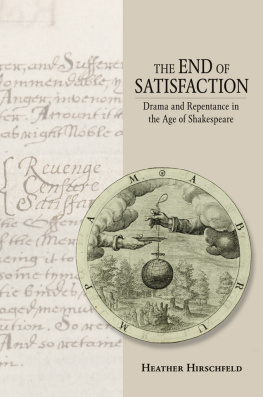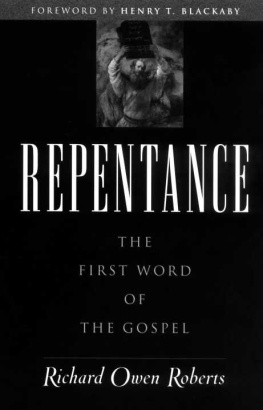Heather Hirschfeld - The end of satisfaction: drama and repentance in the age of Shakespeare
Here you can read online Heather Hirschfeld - The end of satisfaction: drama and repentance in the age of Shakespeare full text of the book (entire story) in english for free. Download pdf and epub, get meaning, cover and reviews about this ebook. year: 2014, publisher: Cornell University Press, genre: Detective and thriller. Description of the work, (preface) as well as reviews are available. Best literature library LitArk.com created for fans of good reading and offers a wide selection of genres:
Romance novel
Science fiction
Adventure
Detective
Science
History
Home and family
Prose
Art
Politics
Computer
Non-fiction
Religion
Business
Children
Humor
Choose a favorite category and find really read worthwhile books. Enjoy immersion in the world of imagination, feel the emotions of the characters or learn something new for yourself, make an fascinating discovery.
- Book:The end of satisfaction: drama and repentance in the age of Shakespeare
- Author:
- Publisher:Cornell University Press
- Genre:
- Year:2014
- Rating:3 / 5
- Favourites:Add to favourites
- Your mark:
- 60
- 1
- 2
- 3
- 4
- 5
The end of satisfaction: drama and repentance in the age of Shakespeare: summary, description and annotation
We offer to read an annotation, description, summary or preface (depends on what the author of the book "The end of satisfaction: drama and repentance in the age of Shakespeare" wrote himself). If you haven't found the necessary information about the book — write in the comments, we will try to find it.
The end of satisfaction: drama and repentance in the age of Shakespeare — read online for free the complete book (whole text) full work
Below is the text of the book, divided by pages. System saving the place of the last page read, allows you to conveniently read the book "The end of satisfaction: drama and repentance in the age of Shakespeare" online for free, without having to search again every time where you left off. Put a bookmark, and you can go to the page where you finished reading at any time.
Font size:
Interval:
Bookmark:
Chapter 1
Adew, to al Popish satisfactions, proclaimed the Protestant clergyman Thomas Wilson in his monumental Christian Dictionarie (1612).
In their written and spoken pronouncements, Reformers invoked and then rejected the sacrament and its definition of satisfaction (penal works It offered, that is, a model of Protestant repentance whose disciplinary procedures and emotional scope did not include satisfaction , enough, as something one made, had, or felt.
Repentance, as recent scholars suggest, was a key Reformation battleground on which vital issues of theology, authority, and social mores were fought out, and theologians on both sides of the confessional divide presented their models with great rhetorical and polemical urgency. In so doing I prepare the background for a detailed, nuanced examination of English Reformers recalibration of the term and the complex assumptions about accounting and atoning for sin the recalibration involved.
What did Thomas Wilson mean by Popish satisfactions? His phrasing is deliberately controversial and pejorative, but in more neutral terms he is referring to the Catholic sacrament of penance, which had developed from
Nowells assertion looks back to a central strand of atonement theory that stressed the sacrificial and satisfactory nature of the redemptive work of the Crucifixion.
The doctrine reached its fullest, most compelling elaboration in the late eleventh-century theologian St. Anselms Cur Deus Homo .
According to Gorringe, this approach refers us back to the beauty of divine nature, This astonishing vacillation between the minimal and maximal values of satis , between precision and excess, is a key feature of Christs atonement. It is also one with which theologians have grappled in their discussions of human atonement.
Human atonement lies at the intersection of Christology and anthropology in satisfaction theory. Tertullian here is interested specifically in confession, but his language assumes more generally the agency of the individual in appealing to the divine. In the course of their own proportionate suffering, that is, humans do enough to compensate for sin, to merit forgiveness, and to return to the solidarity of the church.
Calculating this enough, according to John T. McNeill, began as early as the fourth century, as various councils as well as individual writers attempted to clarify the precise duration and depth of penitential activity.
The individuals contribution to his or her forgiveness remained part of the penitential curriculum of the High Middle Ages, during which time the specific sacramental status of penance was affirmed and a careful distinction between the mortal guilt or debt of sin ( culpa ) and the temporal penalty or punishment of sin ( poena ) was drawn. Desire could, in certain instances, trump doingor, more precisely, desire was equivalent to doing.
Such growing emphasis on intention indicates the subtlety and flexibility of medieval theologies of penance. It also indicates the extent to which medieval doctrine assumed the sinners psychic interiority and individuality. My goal here is neither to argue on behalf of a developed sense of medieval subjectivity (this has already been done with great persuasiveness) Lombard thus sees satisfaction as a penitential stage, following contrition and confession; but he also sees it as the entire work of penance, the accomplishment of all three ways taken together. That work, including feelings of guilt and shame, is understood as pleasurable (cheerful) as well as painful and punitive.
Such a combination of accomplishment and affect was the design of penitential practice in medieval England, including the various Latin and vernacular writings which provided a substantial amount of educational literature on the subject of penanceconfessional manuals, synodalia, sermons, and the like.
Delumeau suggests that manuals like the Speculum and Instructions , as they became increasingly exhaustive and overloaded lists, risked turning confession into a formalized and almost mechanical recitation of a certain number of excessively catalogued offenses. But he also notes the authentic, urgent motive behind those lists: fear of incorrect and sacrilegious confession... and the conviction that God the Creditor kept an exact account of every sin and debt.
These twin pressuresof automization and exactitudeare deeply related to the problem of enough: the difficulty of determining what counts as satis in the enumeration of sins or the prescription and performance of penalties. It is difficult to assign for men what is necessary and what is superfluous ( Sed di ffi cile est assignare que sint necessaria homini et que sint super fl ua ), wrote Thomas of Chobham in his influential thirteenth-century Summa .
But these difficulties, however urgent, never eliminated the basic human ability to satisfacere , to make enough. This ability, of course, was understood And what they did was enough: enough defined as some sort of compensatory activity, whether it was pursuing a virtue to correct a vice, giving alms, extracting mental or physical self-punishment, or, most controversially, purchasing indulgences or sponsoring masses for the dead.
The quintessential articulation of this premise in the late Middle Ages, based on a belief in a divinely instituted, unilateral pact between God and man, was the dictum of Gabriel Biel and the late medieval via moderna : Facere quod in se est , to do what is in oneself. The sinner needed the the exterior rite of the sacrament of penance [to] serve as the means to strengthen mans natural powers, but the thrust of this thinking was to make clear the role of human activity, alongside Gods covenantal disposition, in atonement.
Facere quod in se est : this efficient phrase crystallizes the prevailing logic of penitential satisfaction against which the Reformers, although sensitive to Biels emphasis on contritionism against Scotist sacerdotalism, would take their stand.
It is precisely this transaction which the Reformers of the sixteenth century confronted. Grounded in Luthers recoil from the potential endlessness of confessional enough, accomplishment of, repentance as something that human beings do, make, and, ultimately, feel.
What did Thomas Wilson mean when he bid adew to all Popish satisfactions? His farewell condenses in prankish tones the rejection of human satisfaction for sin initiated by Luther and other European Reformers and then inherited and worked through in England as a central feature in the process of English confessional and national self-definition.
For Luther, Christs sacrificial suffering was a satisfactio su ffi cientissima , a wonderfully paradoxical use of the superlative that recalls Anselm. But, as John Bossy makes clear, Luther, and the Reformers who followed him, differed fundamentally from Anselm in their understanding of the Passion. Although it might appear that Luther concurred with the Anselmian explanation of the Incarnation and Crucifixion, he in fact differed significantly:
He continued to speak of the satisfaction of the wrath of the Father by Christs passion and death.... But he did not mean what Anselm meant by satisfaction.... What in Anselm had been an offer of compensation adequate to turn away due vengeance and restore amicable relation between offended
Bossy sees this difference as a measure of something happening to language.
Continental and English Reformers maintain this shift. Philip Melanchthon attacks the idea of satisfaction particularly for literalizing the economic metaphors of salvationand thus for doing too much in a way that belittles Christ:
Next pageFont size:
Interval:
Bookmark:
Similar books «The end of satisfaction: drama and repentance in the age of Shakespeare»
Look at similar books to The end of satisfaction: drama and repentance in the age of Shakespeare. We have selected literature similar in name and meaning in the hope of providing readers with more options to find new, interesting, not yet read works.
Discussion, reviews of the book The end of satisfaction: drama and repentance in the age of Shakespeare and just readers' own opinions. Leave your comments, write what you think about the work, its meaning or the main characters. Specify what exactly you liked and what you didn't like, and why you think so.










